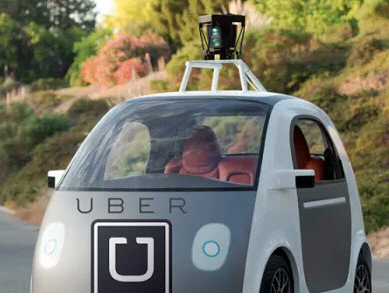Baby Boomers will be surprised to learn that their personal autonomous car has been invented…and it’s called the “TNC, Model 2016.”
Lest the picture deceive, TNC, stands for Transportation Network Company, an acronym for services like Uber, Lyft, Lift Hero and other ride share firms. Ironically, both Uber and Lyft are investing in the technology for autonomous cars. While that technology is under beta testing….more conventional TNC service will suffice for the coming years.
A SPRAWLING DEMAND :
The demand for autonomous cars, via TNC, has to do with the geographic sprawl of Baby Boomers. This is the first generation to settle far from urban areas, and develop homes without spatial links to transit or rail. Because of sprawl and low density, it has been uneconomical to provide transit service, vis a vis road building. Only 17 percent of Boomers live in dense cities with mass transportation. An estimated 70 percent live in areas served by limited or no public transportation (see references, Chapter One, Aging in Suburbia). The remainder have settled in semi-urban areas, where it has been difficult, until now, to solve “first mile/last mile” transportation issues so most Boomers drive.
Meanwhile, cabs/taxi service has been scarce and expensive; spotting a taxi driving on these suburban roads is like encountering an endangered species in the wild. Currently, the popularity of the TNCs has made taxis even less accessible there. Taxi drivers are said to be circulating less and congregating more in places where there is reduced TNC competition like airports. It would be unlikely that a suburban resident could ever “hail” a taxi- that is flag down a vehicle just passing by through the neighborhood. Yet, essentially, that is what a TNC app, enabled by a smart-phone, makes possible. The TNC may be the leveler between urban and suburban transportation.
OLDER TNC DRIVERS:
Meanwhile, a TNC presence is growing in suburbia… in many cases because Boomers are signing up as occasional drivers. It is estimated that a quarter of Uber drivers are age 50 and older. Boomers approaching retirement age find that the gig economy provides them with a spare source of income (next avenue). It also helps them get out and meet other people. And, since Boomers are a generation that generally likes cars, and favors time on the road, driving for Uber or Lyft is an agreeable choice.
Meanwhile, Boomers have a growing demand for an “autonomous car” service. Uber even made a promotional video to explain the benefits.
SEEKING A RIDE:
An essential reason has to do with the age of the Boomer population. Today, the youngest Boomers are age 52 and the oldest are 72. A difficulty driving safely at night is one of the first onsets of advancing age. Yet it is in the evening that people throw parties, patronize the arts and concerts, and go out to eat. One only has to visit the matinee performance of a Broadway show to understand the demographics of those who do not drive after-dark.
So, having a “designated driver” at night is likely to keep Boomers active and engaged…throughout the evening. Although they will not be taking an autonomous car, the TNCs can meet the Boomer’s current need to keep busy and engaged after dark. Over time, the Boomers will seek their “designated driver” for more occasions, expanding from service at night to more daytime trips.
Medical trips are a second arena where the “autonomous car”, via TNC, is making inroads among Boomers. As they age, Boomers need a way to get to and from doctor’s visits, medical centers, and hospitals and these trips are the fastest growing source of their travel demand. Driving your personal car from suburbia, often to a large medical complex in a more urban area, is not fun. There’s the anxiety about the visit, the set-aside time to park the vehicle, and, of course, and the for-profit, per/hour hourly parking charge levied by most medical centers. But the real crunch, and need for the autonomous vehicle comes during the ride home. The driver, in this case the patient, is probably tired, and may be somewhat impaired by a prescription drug or pain reliever. It would be useful if someone, or something else, bore the responsibility for a safe trip back to suburbia.
MORE RIDES, MORE BENEFITS:
The future autonomous car brings other benefits for aging Boomers who settled in aging suburbs. The autonomous vehicle can be regulated to reduce traffic congestion, obey speed limits, and make the streetscape safer for pedestrians and bicyclists too. That can only bode well for Boomers who need to stay healthy and fit outdoors, without driving to exercise and spending hours at the gym.
It will seem odd to Boomers, who have spent so many years of their lives in their car, that they can now liberate themselves from it. But, as they gain years, they will need to shed old habits. Keeping fit, healthy, and socially engaged will take priority for them over almost anything else.
